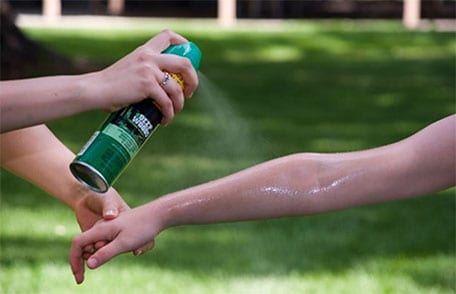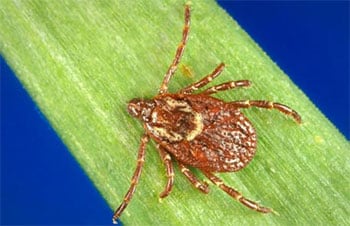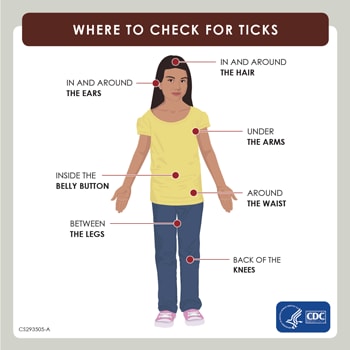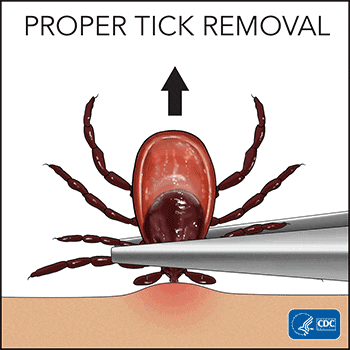Stop Ticks to Avoid Lyme and Other Tickborne Diseases
Ticks carry germs that can cause Lyme disease and Rocky Mountain spotted fever. Use EPA-registered repellents to reduce the chance of being bitten by a tick.

In addition to using repellents, check for ticks and shower after being outdoors to reduce your chance of getting a tickborne disease. Get medical attention if you have a tick bite followed by a fever or rash.
Ticks Can Cause Serious Diseases
A tick bite can cause serious disease such as:
- Anaplasmosis
- Babesiosis
- Ehrlichiosis
- Lyme disease
- Rocky Mountain spotted fever
- Southern tick-associated rash illness
- Tick-borne relapsing fever
- Tularemia
Other diseases that you can get from a tick in the United States include Colorado tick fever and Powassan virus infection.

What kind of tick is this? CDC has images of the most common ticks that bite people.
Before You Go Outdoors
- Know where to expect ticks. Ticks live in grassy, brushy, or wooded areas, or even on animals, so spending time outside camping, gardening, or hunting could bring you in close contact with ticks. Many people get ticks in their own yard or neighborhood.
- Treat clothing and gear with products containing permethrin. Permethrin can be used to treat boots, clothing, and camping gear and remain protective through several washings.
- Use Environmental Protection Agency (EPA)-registered insect repellents containing DEET, picaridin, IR3535, oil of lemon eucalyptus (OLE), para-menthane-diol (PMD), or 2-undecanone. EPA’s helpful search tool can help you find the product that best suits your needs. Always follow product instructions, especially with children.
- Do not use insect repellent on babies younger than 2 months old.
- Do not use products containing OLE or PMD on children under 3 years old.
- If you work outdoors, find more information about protection at the NIOSH Tick-borne Diseases Workplace Safety and Health Topics.

Check your body for ticks after coming indoors.
After You Come Indoors
- Check your clothing for ticks. Ticks may attach to clothing. Remove any ticks and wash clothes or put them in dryer if damp. Tumble dry clothes in a dryer on high heat for 10 minutes to kill ticks on dry clothing after you come indoors. If the clothes are damp, you may need to dry them longer. When washing clothes first, use hot water. Cold and medium temperature water will not kill ticks effectively.
- Check your body for ticks after being outdoors. Conduct a full body check when coming from potentially tick-infested areas, even your back yard. Use a hand-held or full-length mirror to view all parts of your body. Check you and your children for ticks after coming indoors.
- Shower soon after being outdoors. Showering within two hours of coming indoors has been shown to reduce your risk of getting Lyme disease and may be effective in reducing the risk of other tickborne diseases. Showering may help wash off unattached ticks and it is a good opportunity to do a tick check.

To remove a tick, grasp it with tweezers, as close to the skin as possible, and pull it straight out.
What to Do if You Find an Attached Tick
Remove the attached tick as soon as you notice it. Grasp the tick with tweezers, as close to the skin as possible, and pull it straight out. For more information about removing ticks, see the tick removal page.
Watch for signs of sickness such as rash or fever in the days and weeks following the bite. Your risk of getting a tickborne disease depends on many factors, including where you live, the type of tick that bit you, and how long the tick was attached. Be sure to see a health care provider if you become sick after a tick bite, have a rash or a fever.
Reduce Ticks in Your Yard
- Modify your landscape to create tick-safe zones. Similar steps may also help reduce other types of ticks in and around the yard. Remove leaf litter and clear tall grasses and brush around homes regularly. Place wood chips or gravel between lawns and wooded areas to keep ticks away from recreational areas. Keep play areas and playground equipment away from shrubs, bushes, and other vegetation.
- Consider using a chemical control agent. Tick control chemicals are effective for a homeowner to use, or they can be applied by a professional pest control expert.
- Discourage deer. Remove plants that attract deer and construct physical barriers to help discourage deer from entering your yard and bringing blacklegged ticks with them.
Prevent Ticks on Pets
Dogs are very susceptible to tick bites and tickborne diseases. Vaccines are not available for most of the tickborne diseases that dogs can get, and they don’t keep the dogs from bringing ticks into your home. For these reasons, it’s important to use a tick preventive product on your dog. Talk to your veterinarian about the best tick prevention product for your dog. For more information on animals and health, see Preventing Ticks on Your Pet.






















.png)











No hay comentarios:
Publicar un comentario